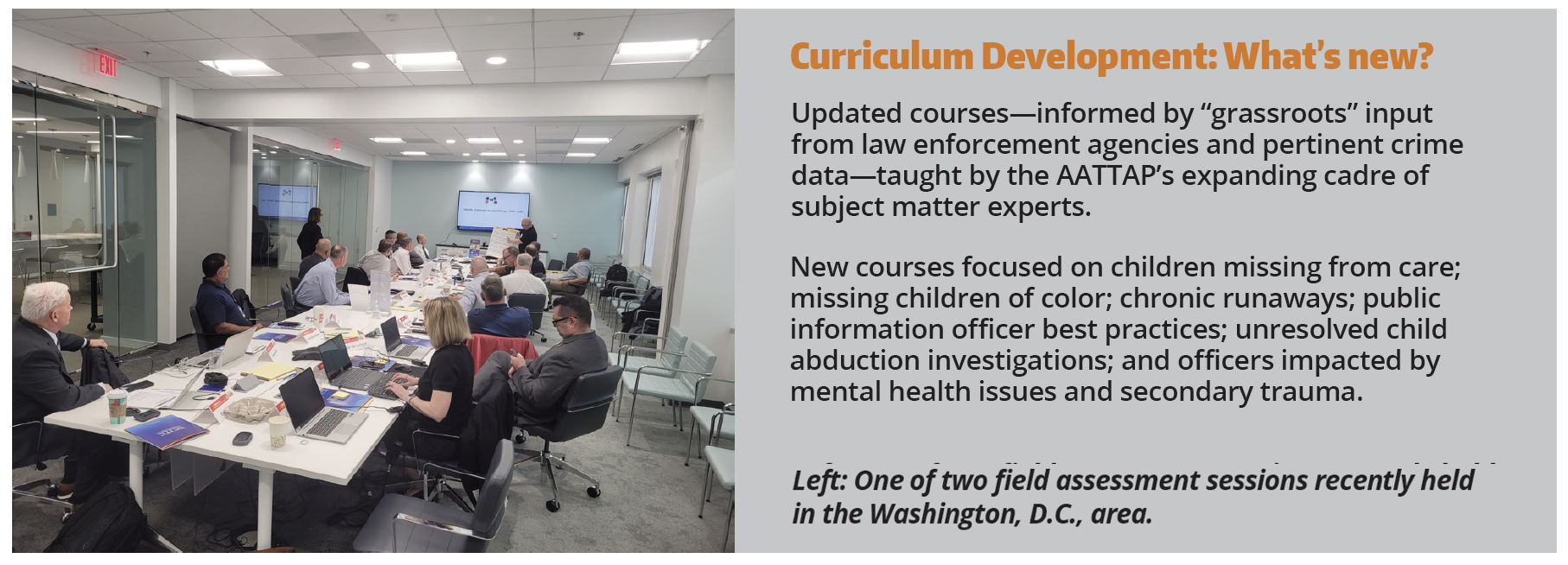Cover Story: 2023 – The Road Ahead
You're in the driver's seat with an array of valuable new educational offerings
Change is inevitable. It’s how we respond to it that counts.
Consider technological advances. They’re an immeasurable help to law enforcement agencies searching for missing children—allowing them to issue AMBER Alerts faster, to geo-targeted areas, and track the digital footprints (banking transactions, app logins, license plate readers) of the people they seek.
But just when the good guys can at least follow the tech learning curve (if not get ahead of it), criminal minds are devising new ways to circumvent detection—trafficking vulnerable, endangered youth not just in recesses of the dark web, but increasingly in plain sight, with coded everyday language meant to mask its true intent.
 Such are the concerns that keep our AATTAP curricula and training teams up at night. The ongoing threat makes us work harder than ever to update and develop courses taught by leading subject matter experts and provide best-in-class training materials for law enforcement and child protection professionals.
Such are the concerns that keep our AATTAP curricula and training teams up at night. The ongoing threat makes us work harder than ever to update and develop courses taught by leading subject matter experts and provide best-in-class training materials for law enforcement and child protection professionals.
With grant support from the U.S. Department of Justice and Office of Juvenile Justice and Delinquency Prevention, the AATTAP is working to share “the very best thinking and practices with law enforcement agencies and child protection partners before problems arise,” says AATTAP Administrator Janell Rasmussen.
She regularly traverses the nation to attend national conferences, Child Abduction Response Team (CART) certifications, onsite training, and Tribal AMBER Alert implementation meetings.
Anticipating how best to prevent, interdict, and prosecute those who would harm children requires paying close attention to emerging crime schemes and observing how criminal justice professionals are successfully solving them.
 “It also takes understanding what training and technical assistance law enforcement agencies actually need, not just what we think they need,” says AATTAP Program Manager Byron Fassett.
“It also takes understanding what training and technical assistance law enforcement agencies actually need, not just what we think they need,” says AATTAP Program Manager Byron Fassett.
The theme for the curriculum development—“by you, for you”—has involved recruiting the nation’s top experts to help develop and deliver new cutting-edge courses and update existing offerings; following emerging technologies and trends; letting reliable data and verifiable trends inform project planning; and creating more flexibility for busy professionals by offering online training that includes self-paced courses, live and recorded webinars, live instructor-led courses, and live hybrid events that combine onsite and online participation.
The goal is to ensure 2023 courses are “relevant and valuable,” says Project Coordinator Cathy Delapaz.
Building ‘responsive’ curriculum
 Cathy and Byron spearheaded two successful field-assessment events this fall in the Washington, D.C., area. Both needs-assessment sessions involved a total of 62 participants “in the trenches” of finding endangered missing children, through investigative work and/or with CARTs.
Cathy and Byron spearheaded two successful field-assessment events this fall in the Washington, D.C., area. Both needs-assessment sessions involved a total of 62 participants “in the trenches” of finding endangered missing children, through investigative work and/or with CARTs.
“We wanted to hear from people in the field who deal with life-and-death situations every day,” Byron says.“We wanted their honest feedback on our curriculum to assess its effectiveness, efficacy and relevance, so we can make it responsive to their needs.”
The new or revamped courses Cathy and Byron are overseeing “will demonstrate in tangible ways how our trainings are field informed. We’re proud of that,” he says.

Priming the ‘front-loaded response’
 Central to AATTAP’s mission is helping law enforcement agencies and their regional partners respond to missing child incidents via fast, efficient, multi-disciplinary CART deployments.
Central to AATTAP’s mission is helping law enforcement agencies and their regional partners respond to missing child incidents via fast, efficient, multi-disciplinary CART deployments.
Project Coordinators Derek VanLuchene and Yesenia “Jesi” Leon-Baron work with an experienced team of trainers to assess CART programs across the country and support their development, training, and certification/re-certification efforts. Jesi also oversees international collaborations, including both the Southern and Northern Border Initiatives (SBI, NBI) that involve partners with Mexico and Canada, respectively.
Having played key roles in supporting the recent field-assessment trainings, Derek and Jesi are focusing not on hypotheticals, but “real-world challenges CARTs face—staffing turnover, the need for regular training, support from leadership, and help obtaining specialized resources,” Derek says.
“We help teams understand they must have resources in place for a front-loaded response—so when they get a call, they’re not scrambling for people or resources,” Jesi adds.

‘Organic outreach’ in Indian Country
 The AMBER in Indian Country team, comprised of Program Manager Tyesha Wood and Project Coordinator Valerie Bribiescas, focuses on helping the nation’s 574 federally recognized Tribes assess their capacity to effectively respond when Native children go missing—and provides educational outreach to prevent such incidents.
The AMBER in Indian Country team, comprised of Program Manager Tyesha Wood and Project Coordinator Valerie Bribiescas, focuses on helping the nation’s 574 federally recognized Tribes assess their capacity to effectively respond when Native children go missing—and provides educational outreach to prevent such incidents.
A big part of the duo's work is helping Tribes understand what resources are available to them thanks to the Ashlynne Mike AMBER Alert in Indian Country Act.
In 2022 the team also began a long-term initiative to provide AMBER Alert in Indian Country Technology Toolkits at no cost to requesting Tribes.
 This year they are continuing that work, and plan to connect with Tribes farther afield, such as Alaska and Maine. Such work requires deft cultural sensitivity. Both Tyesha and Valerie—Navajo Nation members and experienced Tribal detectives—recognize the myriad of complexities involved.
This year they are continuing that work, and plan to connect with Tribes farther afield, such as Alaska and Maine. Such work requires deft cultural sensitivity. Both Tyesha and Valerie—Navajo Nation members and experienced Tribal detectives—recognize the myriad of complexities involved.
“Sovereignty is huge in Indian Country, so we need to know and respect each Tribe’s laws, customs, traditions, greetings, and stories,” Tyesha says.
“Being invited by each Tribe to discuss ways we can help them is essential,” Valerie says.
“We never want to overstep our boundaries with Tribal elders or leadership.”
Relationship-building is especially crucial to emphasize amid changing federal and state laws, such as the controversial McGirt v. Oklahoma ruling in 2020, wherein the U.S. Supreme Court ruled Oklahoma no longer had the right to try criminal cases involving Tribal lands or members.
Navigating jurisdictional battles between states and Tribes can feel like one step forward and two steps back. “We get that,” Tyesha says.
“But we want Tribes to know we’re here for them. We’re here to help them build on strengths and overcome obstacles.”
‘Inform, educate, and inspire’
 Phrases such as “the digital experience,” “asynchronous,” and “accessibility optimization” are often used in the multi-faceted work overseen by Bonnie Ferenbach, Program Manager for AATTAP’s eLearning, Websites, and Publications. Bonnie’s work across all three of these areas focuses on the integrity of content, design quality, functionality, the user experience, and accessibility.
Phrases such as “the digital experience,” “asynchronous,” and “accessibility optimization” are often used in the multi-faceted work overseen by Bonnie Ferenbach, Program Manager for AATTAP’s eLearning, Websites, and Publications. Bonnie’s work across all three of these areas focuses on the integrity of content, design quality, functionality, the user experience, and accessibility.
She also is a seasoned presenter and instructor with experience in developing and guiding law enforcement telecommunications operational response to missing and abducted child incidents.
 It was that work which brought her to AATTAP as a consultant in 2006. She helped develop the “Telecommunications Best Practices for Missing and Abducted Children” course, which has been delivered both online and in the classroom for more than 15 years.
It was that work which brought her to AATTAP as a consultant in 2006. She helped develop the “Telecommunications Best Practices for Missing and Abducted Children” course, which has been delivered both online and in the classroom for more than 15 years.
When not focused on eLearning initiatives, Bonnie collaborates with Project Coordinator Denise Gee Peacock to develop engaging and educational content for The AMBER Advocate and various online platformsContent is delivered across both The AMBER Advocate (amberadvocate.org) and the AMBER Alert in Indian Country (amber-ic.org) websites, along with a vast array of resources and training information.
“We want the AMBERAdvocate.org site to be as informative as it is interactive,” Bonnie explains, noting the community of practice dimension of the website’s Partner Portal.
The secure platform allows AMBER Alert Coordinators, Missing Persons Clearinghouse Managers, and others to find contact information for colleagues in similar positions across the nation, engage in discussion forums around an array of topics important to their work, and utilize and contribute to an extensive resource library.
Support, passion make a difference
With its complex operations, none of the AATTAP and AIIC gears would turn without the exceptional team that coordinates the logistics and monitors the feasibility and effectiveness of the team’s many projects.
At the group’s helm is Program Manager Jenniffer Price-Lehmann, who monitors budgeting and financials.
 She works closely with Janell in overseeing the budget and grant management, as well as major events, to ensure the work we do is consistent with our mission as well as that of our federal grantors.
She works closely with Janell in overseeing the budget and grant management, as well as major events, to ensure the work we do is consistent with our mission as well as that of our federal grantors.
She’s also recognized as a stellar problem solver, metrics monitor, mentor, and cross-function/team collaboration strategist.
Jenniffer works closely with a dynamic duo she calls “the unsung heroes of the program”—Project Coordinator Jill Nysse and Mishelle Bowen, Administrative Assistant.
“Both are dedicated to ensuring training operates smoothly and participants and instructors have all the tools they need,” Jenniffer says.
On any given day they are securing adequate space for onsite training events, coordinating the shipment of materials, booking lodging, helping instructors build and adjust travel itineraries; finalizing program records and documentation; and helping participants access online training and resources.
Jill is motivated by the powerful stories shared by AATTAP “family members”—parents and siblings of missing children. Understanding their struggles puts any trivial matters into perspective “when I realize I’m helping children and making the world a better place.”
The same goes for Mishelle. She mentions an online encounter with a police officer trying to access a virtual, live course. After she provided the help he needed, his follow-up note was more than a simple “thank you.”
“A few weeks after taking the course he let me know his team was put to the test by a case involving a missing child,” Mishelle says. “But because of what they had learned during the training session, he and his colleagues were able to safely locate the child.” That still resonates with her. “It reminds me that what we do really makes a difference.”


